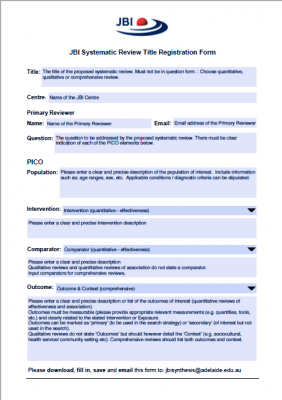
SYSTEMATIC REVIEW REGISTER
JBI has developed a collection of world-class resources driven by the needs of health professionals and consumers worldwide.
Registration of Systematic Review Titles
Please note: this register is for the use of JBI affiliated entities ONLY. Registration of a systematic review title on the JBI website is to promote collaboration between affiliated entities via highlighting current work to other JBI review authors and to recognise that the registered topic is currently in development to avoid any unintended and/or unnecessary duplication of research effort.
Registered systematic reviews that are currently underway are listed below. Protocols for these reviews may already be published or in preparation for publication within six months of initial registration. To avoid duplication, titles in this list should not be replicated by other review authors. Please contact the listed Primary Reviewer or the JBI Synthesis Science Unit if you would like further information about any of these registered reviews.
Registration of titles on this web page does not in any way constitute acceptance of the topic by JBI Evidence Synthesis.

| Title | Certified authors | Collaborating Entity or Institution | Date registered | Custom text |
|---|---|---|---|---|
| Supportive care interventions for women with cancer from ethnic minority backgrounds: a scoping review | Dr Suzanne Grant | The New South Wales Centre for Evidence Based Health Care: A JBI Centre of Excellence | The New South Wales Centre for Evidence Based Health Care: A JBI Centre of Excellence
Dr Suzanne Grant
|
|
| The use of mushrooms in lung cancer: a scoping review | Suzanne Grant and Xun Li | The New South Wales Centre for Evidence Based Health Care: A JBI Centre of Excellence | The New South Wales Centre for Evidence Based Health Care: A JBI Centre of Excellence
Suzanne Grant and Xun Li
|
|
| Consumer experiences of short peripheral intravenous and midline catheters in acute healthcare: a mixed methods systematic review and meta-analysis | Michelle NELSON | The Centre for Evidence Informed Nursing, Midwifery and Healthcare Practice: A JBI Centre of Excellence | The Centre for Evidence Informed Nursing, Midwifery and Healthcare Practice: A JBI Centre of Excellence
Michelle NELSON
Adult patients and adult carers of paediatric and neonatal patients. |